Following our review of the 85mm that was published a few days ago, we are now here with our full review of the second Batis lens released by Zeiss, the 25mm f/2. The renowned German brand clearly sees Sony E-Mount as a system worth investing in, especially now that there are so many full frame cameras available. While the Loxia lens family is aimed at manual focus lovers who appreciate traditional distance scales and mechanical rings, the Batis family has more modern characteristics that include autofocus and the world’s first OLED screen on a lens.
The 2/25 is the third fastest wide angle prime to be designed for the FE system in addition to the Sony 28mm f/2 and the Sony/Zeiss 35mm f/1.4. I wasn’t sure how much I would like the 25mm focal length at first but it turned out to be a very versatile lens for street, landscape and architecture. Its fast aperture is useful for many applications, such as events, wedding and astro-photography.
Is the Batis 25mm a great addition to the Sony FE lens line-up? Let’s find out!



Zeiss Batis 25mm f/2 Main Specs
- Focal length: 25mm
- Maximum aperture: 2
- Minimum aperture: 22
- Angle of view: 82°
- Closest focusing distance: 20cm
- Lens configuration: 10 elements / 8 groups
- Special elements: 2 Aspherical, 2 Special Glass, 1 Aspherical special glass elements
- Lens surface coating: Yes (T* Coating)
- Maximum image magnification: 1/5.2
- Optical Image Stabilizer: No
- Dimensions: φ78mm Ø, 92 mm
- Filter diamater: 67mm
- Weight: 335g
Table of Contents
Below you can check out our hands-on video review of the two Batis lenses where we also show you exactly how the OLED screen works and how to select the various options.
Design and ease of use
The 2/25 has inherited the same design as the Touit lenses (APS-C E and X mounts) and Batis 85mm, including the all-metal build and the focus ring covered with rubber. The petal-shaped plastic hood perfectly matches the lens diameter and looks like a natural extension of the lens itself. The build quality is robust and the lens body is splash and dust proof.
The Batis 25mm is fairly light and its size is an excellent match for the A7 bodies. It is large in diameter but I find it easy to carry around and with the hood reversed, it can fit into small bags such as the Cosyspeed Camslinger 160. It isn’t as long as the Batis 1.8/85 but both lenses have the same diameter, which also means that they have the same 67mm filter thread.
The rubber focus ring has a very nice feel. Zeiss decided to use this material so that photographers can easily use the lens in cold environments without gloves. The only downside is that the rubber attracts more dust. The focus ring is not mechanical but “fly-by-wire”. It is smooth and precise to use. As in the case of the Batis 85mm, the only thing I miss a little is an aperture ring.
Both Batis lenses have a unique characteristic, which is their OLED screen. By default it only activates when you use the camera in manual focus mode. You can however decide to activate it in autofocus mode or turn it off completely (more on that in a few paragraphs). When you turn the camera on, the Zeiss name appears briefly on the screen.

In manual focus mode, the OLED screen gives you the same information you would find on a classic distance scale. At the centre, the biggest number shows the precise distance at which you are focusing. The smaller numbers on the side give you the depth of field according to your focus distance and aperture. The more you decrease your aperture, the deeper your depth of field will be. At the shortest focus distance, the depth of field is shown in decimals at the right side of the screen.
I find this OLED screen more useful on the Batis 25mm than on the Batis 85mm.
Photographers are more likely to use the hyperfocal scale for street photography with a wide angle lens than with a portrait lens, and the same applies to astrophotography. When I went out one night to photograph the Milky Way, the OLED screen helped me to make sure that my focus distance was always at infinity when I moved the tripod and camera from one place to another. The first few times, I checked my focus using the LCD screen and the magnification option as well, and I found that the exact infinity point on the lens is reached when the infinity symbol first appears on the screen. If you keep turning the ring, the lens will still indicate that you are at infinity but when you check the LCD screen, you’ll notice that the image is slightly blurry. I have to say that in that particular situation, it was a neat thing to have. In sunlight, however, the numbers can be more difficult to read depending on the light and the angle. In this case, a classic distance scale can be easier to read.
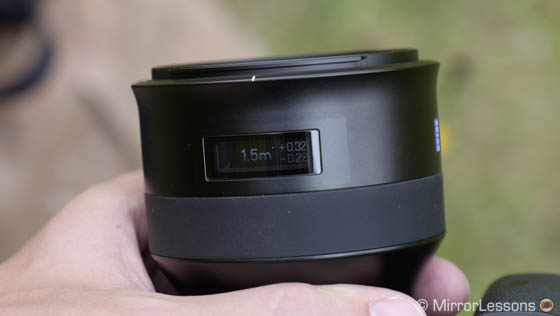
Tip: switching from metres to feet, turning the OLED screen ON/OFF
The distance scale is expressed in metres by default. You can switch it to feet by using the focus ring. Rotate it until you reach the minimum focus distance (an arrow on the left will appear once you are at the shortest distance). Then keep rotating in the same direction for 360° and the scale will change from metres to feet. The same process works if you want to switch back to metres.
The OLED screen can be activated in autofocus mode or turned off completely. Turn the ring in the opposite direction until you reach infinity (an arrow on the right will appear). Then keep turning for 360° in the same direction and an ON/OFF option will appear. Keep turning in the same direction again to select one of the various options:
- ON (remains activated no matter which focus mode you select)
- MF (activates only for manual focusing)
- OFF (remains deactivated in both focusing modes).
To validate, simply turn the ring in the opposite direction.
Through the lens: image quality
The Batis 25mm might not be a focal length that appeals to everyone because when it comes to wide angles, those few extra millimetres can make a real difference. For some it might not be wide enough, while for others it might be too wide. Here in Wales, I found the lens very useful for landscapes, architecture and street. Its main strength is without a doubt sharpness. It is already sharp at its fastest aperture and maintains very good performance across the entire frame. Centre sharpness is already excellent at f/2.8 with the sweet spot being around f/5.6. The corners are excellent from f/4.

Click to open the full res image.


100% Centre Crop (click to open it)
100% Centre Crop (click to open it)
The lens also gives you excellent contrast, and a natural and precise colour rendition. It is a great lens for landscape photography.

Click on the image to open the full sized version.

At f/2 the sharpness is already excellent especially when focusing at short distances. It is at this aperture that the Distagon also shows off its excellent bokeh (as long as your subject is very close).

Click on the image to open the full size version.



The fact that its performance is already good at f/2 is important for low-light photography, especially astrophotography . Below you can see other pictures taken with the A7s.


The only real flaw I found on this lens was vignetting. It can be quite severe on the Sony A7r. It disappears almost completely only at the slowest aperture. On the A7s, vignetting is less intense and disappears almost completely at f/5.6.
Update: the latest Lightroom (2015.1.1) and Adobe Camera Raw (9.1.1) releases include the Batis profiles. You can get rid of vignetting with one click.
Below is an example at f/2.8:
- Slide to the right: A7r version
- Slide to the left: A7s version
Then a second example at f/8:
- Slide to the right: A7r version
- Slide to the left: A7s version
There can also be chromatic aberration especially at the corners and at more closed apertures like f/5.6 as you can see in the example below. But both vignetting and chromatic aberration can be removed in Lightroom.

Click on the image to open the full size version.
Below a crop of an area affected with CA:
- Slide to the right: untouched version
- Slide to the left: corrected version with Lightroom
The Batis 25mm has the Zeiss T* coating and as a result handles flare and backlit situations really well. I only found some small and discreet flares in some pictures that I took with the actual purpose of generating flare. In normal use, it is unlikely that you’ll have to deal with flare very often.


When it comes to distortion, there is some perspective distortion especially when shooting interiors or when dealing with architecture at the corners but that is normal. I found some barrel distortion with elements that are closer to you. Here again, the latter can be easily corrected. I used the lens both for exterior and interior architecture and it is a valid option. Perhaps future updates of Lightroom will include the Batis lens profiles so that you can correct distortion with a click of a mouse.




Below you can see an example with some barrel distortion:
- Slide to the right: original distortion
- Slide to the left: distortion corrected with Lightroom
Update: the latest Lightroom (2015.1.1) and Adobe Camera Raw (9.1.1) releases include the Batis profiles. You can get rid of barrel distortion with one click.
Autofocus and performance
The lens’ autofocus motor is fast and silent. I honestly didn’t find anything in particular to complain about. It proved reliable on the A7r, the A7s and the a6000.

The lens doesn’t include optical stabilisation. This won’t be a problem on the A7 mark II and the A7r mark II since they include sensor stabilisation. With the other A7 cameras, you will have to make do. Personally, I managed to take sharp shots down to 1/15s with the A7r. I took a few shots in a row and of course tried to be as steady as possible.

The Batis 2/25 on the Sony a6000
Does this lens make sense on Sony’s APS-C cameras as well? I used it on the a6000 for a few hours on the streets. The lens gives you a field of view of 37.5mm which is slightly longer than the typical 35mm focal length street photographers love. The lens behaves really well and since the camera doesn’t use the entire lens surface, you won’t get any vignetting or chromatic aberration at the corners.

However I would only recommend it if you plan on using it primarily on a full-frame camera. If you are looking for a similar focal length to use on your Sony Nex/APS-C camera, there is already the excellent 24mm f/1.8, which is smaller and slightly less expensive.
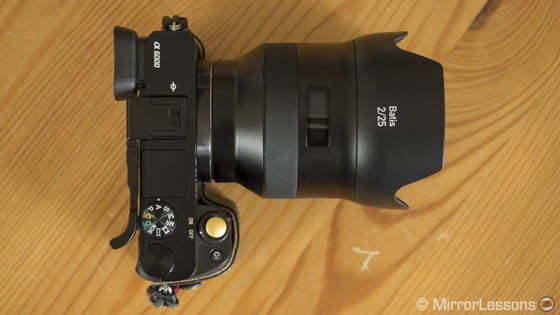
Conclusion
The Zeiss Batis 25mm is yet another great lens for the Sony FE system. It isn’t perfect and vignetting can be the most annoying thing to deal with especially on the A7r. There is also some barrel distortion that can be easily fixed in post-production. Otherwise, it provides great sharpness, is perfectly usable at f/2 and has an excellent bokeh rendering when you focus close. It has a fast autofocus mechanism and the OLED screen can be useful for astrophotographers.
Whether you’d add this lens to your bag mostly depends on how much you like this focal length: I generally like the 24mm angle of view, so for me, moving to 25mm wasn’t a big leap. However, it may not be wide enough in some situations and since it isn’t a cheap lens, you should only buy it if you are 100% sure that you want that exact field of view.

Zeiss now has two E-mount series for the full frame system and I am curious to see what will be released next. Though both Batis lenses are excellent, I personally still prefer the form factor of the Loxia family. Their size and weight fit the A7 cameras to a T and keep the system small and portable. (That said, there isn’t yet an “exclusive” Loxia focal length that we haven’t already seen from the autofocus department.) The Batis lenses could be a nice alternative to the Sony lenses if Zeiss manages to keep their size and weight reasonable and continues to provide other useful focal lengths like the first two.
 What I like about the Zeiss Batis 25mm f/2:
What I like about the Zeiss Batis 25mm f/2:
- Excellent sharpness at the centre and the corners
- Beautiful bokeh when you focus close
- Good size/weight for the A7 bodies
- The OLED screen is very useful for astrophotographers
 What I don’t like about the Zeiss Batis 25mm f/2:
What I don’t like about the Zeiss Batis 25mm f/2:
- Vignetting is severe especially on the A7r (but easily removable in Lightroom 2015.1.1 or ACR 9.1.1)
- Some barrel distortion (but easily removable in Lightroom 2015.1.1 or ACR 9.1.1)
- Some chromatic aberration at the corners
You can check out other full res images here. And don’t forget to read our Batis 1.8/85mm review as well!
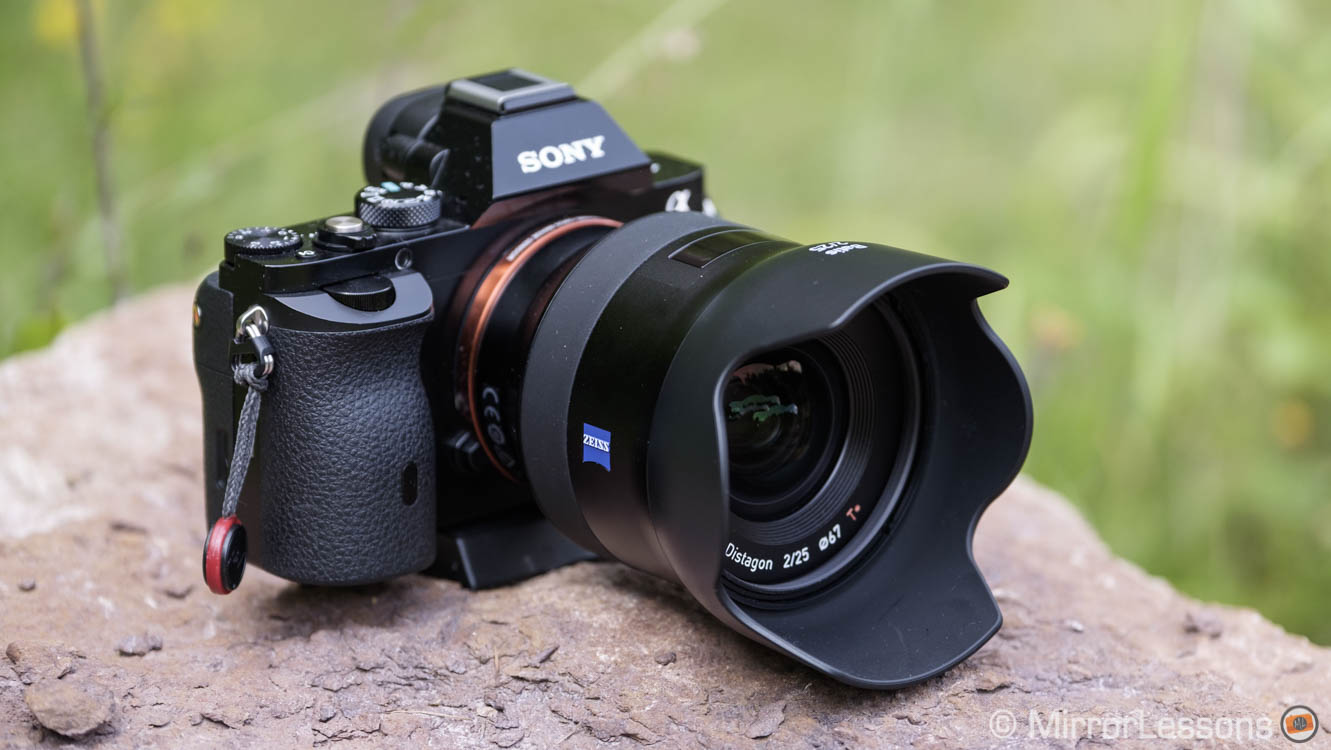
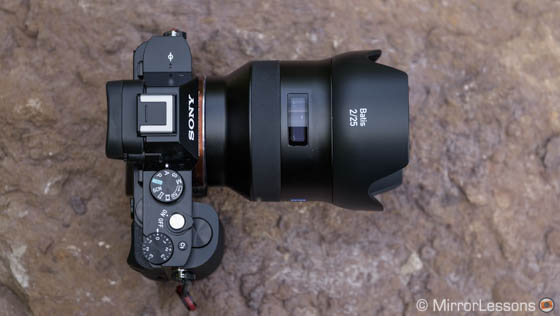
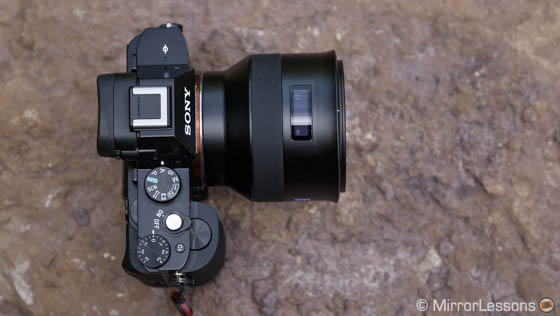
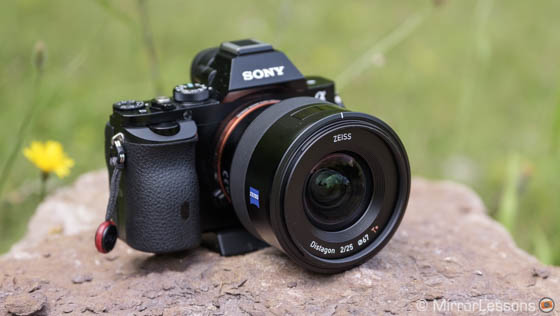

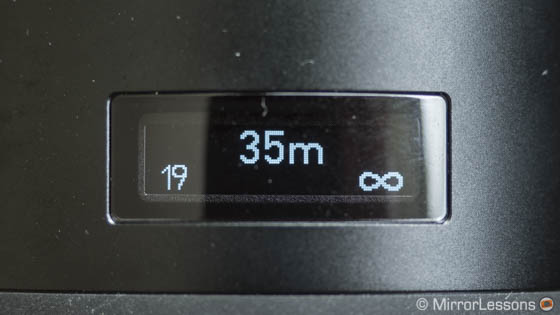
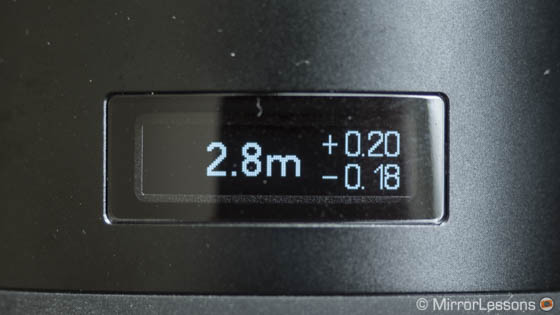

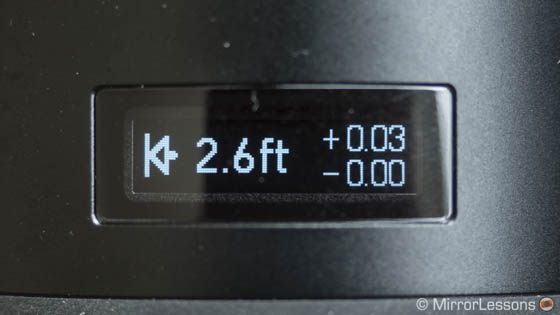












Great, let me know how do you find it! 😉
I’m excited to rent it for some street-shooting at the end of October. Yeah, I should have rented the Zony 24 mm, but this is, for some reason, a cheaper rental!
Thanks, glad you appreciate it 🙂
Thanks for having a test with the A6000 APS-C as well. Great test all over.
Hi, no I haven’t noticed any.
Thanks for your review. It would be very helpful to know if you noticed any coma (comatic aberration) during your astrophotography tests.
Yes perspective distortion is natural for a wide angle lens. I updated the text to create less confusion. Thanks for pointing it out 😉
A lens can also distort perspective more than others. But yes it natural for a wide angle lens.
Re: “When it comes to distortion, I found some perspective distortion
especially when shooting interiors or when dealing with architecture at
the corners. There is also some barrel distortion with elements that are
closer to you.”
A lens cannot cause perspective distortion; perspective distortion is a result of the relative positions of the camera and subject. Barrel, pincushion, and various wavy-line distortions are all types of geometric distortion, and are a function of the lens.